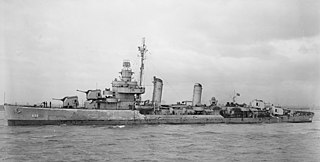
USS Knight (DD-633), a Gleaves-class destroyer, is the only ship of the United States Navy to be named for Admiral Austin M. Knight.

The third USS Decatur (DD-341) was a Clemson-class destroyer in the United States Navy following World War I. She was named for Stephen Decatur.

USS Seer (AM-112/MSF-112/MMC-5) was an Auk-class minesweeper of the United States Navy that served during World War II and the Korean War, and was sold to Norway in 1962.

USS Bernalillo County (LST-306) was an LST-1-class tank landing ship built for the United States Navy during World War II. Named for Bernalillo County, New Mexico, she was the only U.S. Naval vessel to bear the name.

USS Sentinel (AM-113) was an Auk-class minesweeper built for the United States Navy during World War II; she was the third U.S. Naval vessel to bear the name. It was laid down on 28 November 1941 by the American Ship Building Company, Cleveland, Ohio; launched on 23 May 1942; and commissioned on 3 November 1942.

USS Speed (AM-116) was an Auk-class minesweeper acquired by the United States Navy for the dangerous task of removing mines from minefields laid in the water to prevent ships from passing.
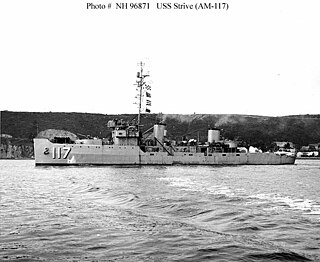
USS Strive (AM-117) was an Auk-class minesweeper acquired by the United States Navy for the dangerous task of removing mines from minefields laid in the water to prevent ships from passing.

USS Steady (AM-118) was an Auk-class minesweeper acquired by the United States Navy for the dangerous task of removing mines from minefields laid in the water to prevent ships from passing.
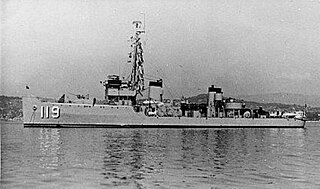
USS Sustain (AM-119) was an Auk-class minesweeper acquired by the United States Navy for the dangerous task of removing mines from minefields laid in the water to prevent ships from passing.

USS Owl (AM-2) was an Lapwing-class minesweeper acquired by the U.S. Navy for the dangerous task of removing mines from minefields laid in the water to prevent ships from passing.

USS Redwing (AM-48) was an Lapwing-class minesweeper commissioned by the United States Navy for service in World War I. She was responsible for removing mines from harbors, and, in her role as rescue and salvage ship, she was responsible for coming to the aid of stricken vessels. She was laid down 5 August 1918 by the Baltimore Drydock & Shipbuilding Co., Baltimore, Maryland; launched 7 June 1919; sponsored by Mrs. Fred A. Plagemann, wife of the prospective commanding officer; and commissioned 17 October 1919.
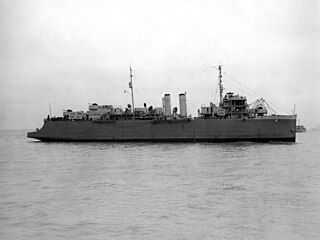
USS Weehawken (CM-12) was originally SS Estrada Palma – a car ferry built in 1920 by William Cramp & Sons of Philadelphia. It was acquired by the United States Navy on 15 June 1942; renamed Weehawken on 18 July 1942; converted to a minelayer by the Bethlehem Steel Co. at Hoboken, New Jersey; designated CM-12; and commissioned on 30 September 1942.

USS Sellstrom (DE-255) was an Edsall-class destroyer escort built for the U.S. Navy during World War II. She served in the Atlantic Ocean, the Pacific Ocean and provided destroyer escort protection against submarine and air attack for Navy vessels and convoys.

USS Moreno (AT-87) was a Navajo-class fleet tug constructed for the United States Navy during World War II. Her purpose was to aid ships, usually by towing, on the high seas or in combat or post-combat areas, plus "other duties as assigned." She served in the Atlantic Ocean and, at war's end, returned home with three battle stars to her credit.
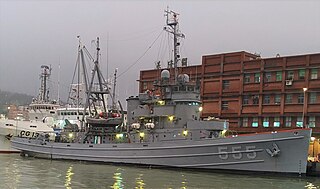
USS Narragansett (AT-88) was a Navajo-class fleet tug constructed for the United States Navy during World War II. Her purpose was to aid ships, usually by towing, on the high seas or in combat or post-combat areas, plus "other duties as assigned." She served in the Atlantic Ocean and, at war’s end, returned home with three battle stars to her credit.
USS Tackle (ARS-37) was a Tackle-class rescue and salvage ship acquired by the U.S. Navy during World War II. She served in North Atlantic waters, and returned home at war's end with two battle stars.

USS Kewaydin (AT-24) was an Bagaduce-class fleet tug laid down for the U.S. Navy in the closing days of World War I and continued in operation throughout World War II.

The third USS Kiowa (AT-72), later ATF-72, was a fleet tug, later fleet ocean tug, that served in the United States Navy from 1943 to 1972.

USS Choctaw (AT-70) was a Navajo-class fleet tug constructed for the United States Navy during World War II. Her purpose was to aid ships, usually by towing, on the high seas or in combat or post-combat areas, plus "other duties as assigned." She served in Bermuda during the end of World War II where she was primarily responsible to aiding in the assembly of convoys and ships taking part in training. On 15 May 1944, she was redesignated ATF-70. She continued to serve for 3 more years before being decommissioned on 11 March 1947.

USS Hopi (AT-71) was a Navajo-class fleet tug constructed for the United States Navy during World War II. Her purpose was to aid ships, usually by towing, on the high seas or in combat or post-combat areas, plus "other duties as assigned." During World War II she was assigned to the Europe-Africa-Middle East Theater where she participated in four campaigns earning four battle stars.




















